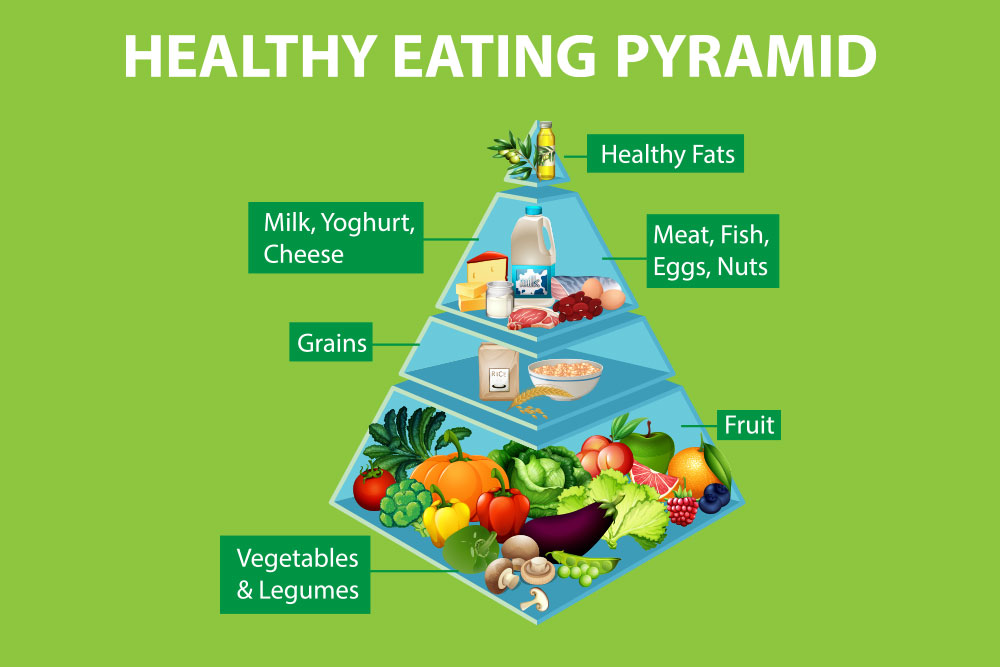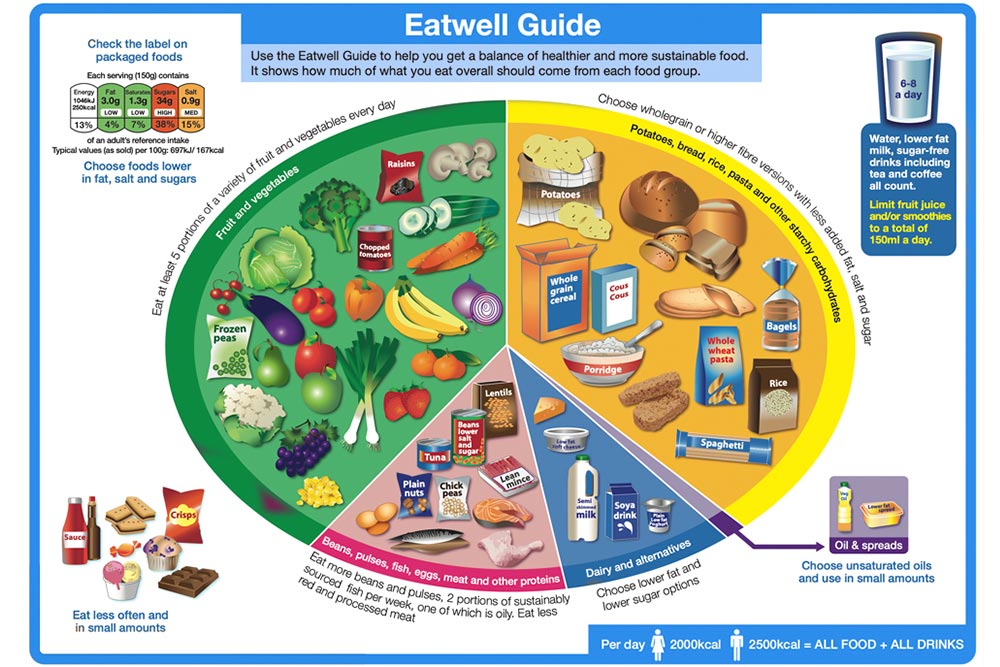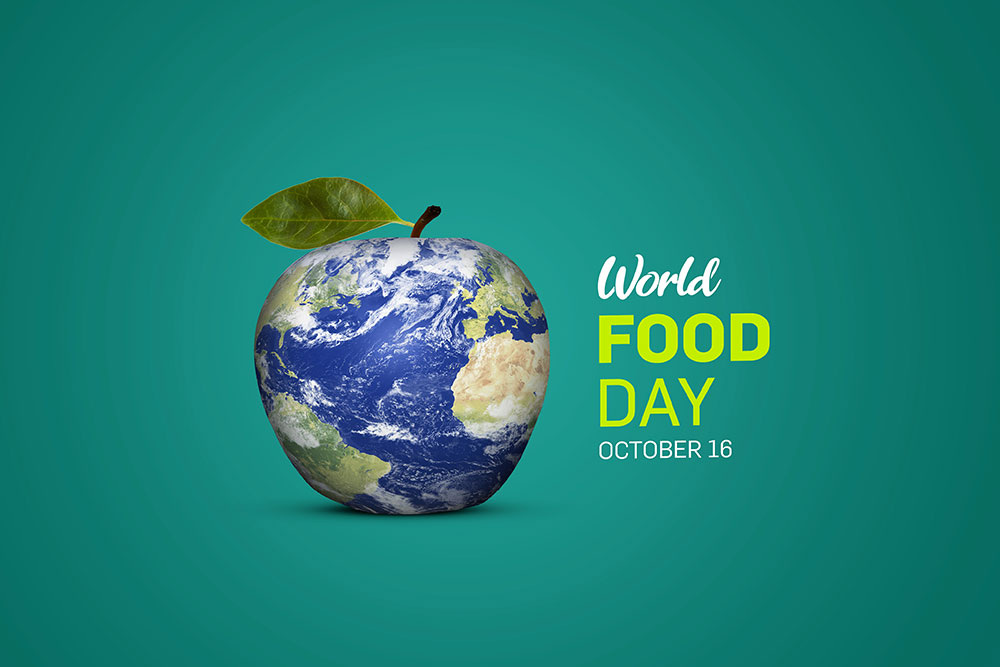
It’s hard to maintain a healthy diet.
Guidance seems to change every month – manufacturers sometimes also make misleading claims. For every piece of expert advice, you can usually find an equally credible source stating the opposite.
Sometimes, it’s best to keep things simple. This is where the food pyramid helps.
It’s a straightforward tool to help you plan your diet and make healthier choices.
Read our guide to learn more about the food pyramid and how you can use it as your guide to eating well.
The Benefits of Healthy Eating
It’s a well-known fact that diet directly impacts our health. But sometimes, we underestimate how much our foods affect us.
There are apparent short-term impacts – eating well helps you feel good and sustain a healthy weight. Research suggests that good nutrition helps improve mental health and our capacity to think – not just because it’s difficult to concentrate while hungry.
Studies have also shown multiple long-term benefits of a healthy diet. Eating well helps reduce the risk of heart disease, diabetes, osteoporosis, and certain cancers. There has even been evidence that a good diet can protect against cognitive decline in old age.
Food Hygiene Courses
Equip food workers with essential training for their role. Our online food hygiene courses provide an understanding of food safety, HACCP systems and cross-contamination. All courses award independently recognised certificates for proof of training.
The Food Pyramid Explained
Much like its ancient Egyptian namesakes, the food pyramid has existed for some time. But this doesn’t mean the advice is outdated. In fact, the food pyramid represents the fundamentals of nutrition all health professionals agree on.

The visual design of the food pyramid also makes it easy to see how you should structure your diet. Just as fruits and vegetables make up the base of the pyramid, they should also form the base of any healthy diet. And as each layer of the pyramid gets progressively smaller, the food group it represents should make up a smaller percentage of your diet.
It’s important to note that you don’t need to apply the principles of the healthy eating pyramid to every meal. Instead, think about your choices for a day or, even better, a week. Thinking about your diet in broader terms allows for the occasional treat, which can be included in a healthy diet.
Fruits and Vegetables
Fruits and vegetables are the foundation of the food pyramid and should be the foundation of any healthy diet. They’re a fantastic source of vitamins and minerals your body needs to function and a great source of dietary fibre, which aids digestion.
You should aim for at least five portions of fruits and vegetables each day. However, some nutritionists recommend seven daily portions. A portion is around 80 grams or about a handful. Fresh servings are generally preferable, but tinned, dried or frozen options all count towards the recommended intake.
You should eat various fruits and vegetables to get diverse nutrients. Try to make each portion different. A general rule of thumb is that fruits and vegetables of different colours offer different nutrients, so try to eat as colourful a diet as possible.
Don’t panic if you fail to get your recommended five daily portions. Just like your overall diet, it helps to think of nutrition over the long term. As long as you get a healthy amount (and variety) of fruits and vegetables every week, you should give your body the nutrition it needs.
Starchy Foods
The next level of the food pyramid is made up of starchy foods – foods such as breads, grains, rice, pasta and potatoes. (It’s true, potatoes don’t count as vegetables.)
Starchy foods should make up less of your diet than fruits and vegetables but still be one of your staples. They’re rich in carbohydrates, your body’s preferred energy source.
Some of you might be shocked to find carbohydrates being promoted as part of a healthy diet since many weight-loss programmes recommend reducing your intake or cutting them out entirely. While not all carbohydrates are equally suitable, your body needs a steady source to maintain energy levels and function normally. Avoid overly processed carbohydrates and stick to whole grains or minimally processed alternatives.
Dairy (and Alternatives)
Moving up the pyramid, we have dairy products – milk, cheeses, and yoghurt. The nutrients in dairy products help promote bone health and protect against cardiovascular disease.
Despite a re-appraisal of fats in our diets (more on that later), the general advice is to opt for low-fat versions as dairy products. Most fats in dairy products are saturated, which most nutritionists agree should be limited in our diets. However, be cautious when choosing low or no-fat alternatives, as some manufacturers add sugar to compensate for the potential lack of taste.
Suppose you follow a vegan diet or are lactose intolerant. In that case, you can benefit similarly from alternatives such as plant-based milk or cheeses. If you are opting for substitutes, be mindful of their nutritional value. Good options will be supplemented with calcium, vitamin D and other nutrients regularly found in dairy products. Soy-based products, like tofu and leafy greens, are also good sources of calcium for vegans.
High-Protein Foods
Protein is needed for your body to grow and repair cells. Most people use meat as their primary source of protein.
You should choose lean meats, such as chicken or turkey, whenever possible and limit your intake of red meat. And similar to carbohydrates, the less processed the product is, the better it’ll likely be for you.
It’s also recommended to eat regular portions of fish. Seafood is often low in calories while giving you a hefty dose of protein. Oily fish, such as mackerel or salmon, are also excellent sources of Omega-3 fatty acids, which are good for your heart.
For vegetarians, beans, legumes and pulses are all protein-rich, as are nuts and certain grains. Eggs are also a great option because they’re a complete protein source, giving you all nine essential amino acids your body needs. This is particularly important for those following a vegetarian diet, as plant-based proteins often lack the full range of amino acids.
But don’t think you can’t get everything you need from a plant-based diet. Getting all the protein your body needs without meat or other animal products is possible but requires planning. More advice on getting the nutrients you need exclusively from plant-based foods is available lately.
Fats, Spreads & Oils
As the size of this level suggests, fats, spreads and oils should be a relatively small part of your diet. However, this comes with a caveat.
Fats are calorie-dense, which means a diet rich in high-fat foods can easily lead to weight gain. Fatty foods, mainly those high in saturated fat, are also linked to high cholesterol, which can cause heart disease.
But as long as you’re not exceeding recommended calorie counts for your activity levels, certain fats should be a mainstay of your diet.
The abovementioned omega-3 fatty acids have a positive impact on heart health. You can get a good dose of these healthy fats from oily fish. Plant-based eaters can opt for flaxseed oil, walnuts or avocados.
In fact, plant-based fats are beneficial for any diet as they often contain polyunsaturated fats, which are considered the healthiest type. Nuts, seeds and olive oils are all more nutritious choices, with olive oil often being touted as one of the key reasons the Mediterranean diet is so good for us.
Treats
They saved the best for last!
The top of the pyramid is comprised of ‘treats’ – foods high in sugar, salt, and saturated fats. The occasional treat won’t harm you, but limit these indulgences to one or two a week.
The Healthy Eating Plate
The food pyramid isn’t the only widely accepted guide for healthy eating. Some organisations prefer to present this information using the healthy eating plate or, as the NHS calls it, the Eatwell Guide.

Whatever form the guidance takes, the principles are primarily the same. Like the healthy eating pyramid, its plate-based cousin outlines a balanced diet. You might find the healthy eating plate more helpful when planning specific meals as it represents the type and quantities of foods you should include.
It’s similar to the food pyramid; however, you should see the healthy eating plate as a guide to your overall diet, not necessarily something you must follow for every meal.
World Food Day
World Food Day 2023 will be celebrated close to the publishing date of this blog. This year’s event focuses on water and its importance in food supply chains.
It might seem counterintuitive to theme World Food Day around water. Still, there are two reasons the Food and Agricultural Organisation of the United Nations (FAO), which runs the campaign, has adopted this position:
- Our planet’s water resources are being increasingly stretched
- Around 2.4 billion people live in water-stressed countries
There are multiple reasons why access to fresh water is growing more limited, with rapid urbanisation, pollution and climate change being three of the most pressing concerns.
Without sustainable, equitable water management, entire communities may lose access to water resources permanently. This will be catastrophic, driving conflict, inequality and loss of life.

What You Can Do
One of the event’s key messages is to stop taking water for granted. Water use is rarely a factor when choosing what we eat, but food production directly impacts water resources.
Choose local, seasonal products whenever possible, which are far more water-efficient. (This will also help you get more fresh fruits and vegetables into your diet.) You can also take steps to reduce food waste and avoid water pollution. More detailed guidance is available from the FAO.
Other Eating Habits to Consider
Healthy eating is a habit that takes time to get into it. You must learn which foods make up a balanced diet and ensure you eat them regularly. Like with most new behaviours, it’s easier to make them stick if you educate yourself first. Knowing what foods your body needs is only part of the formula; the most important thing is understanding how to prepare them.
If you work in the food industry, you need to know the ins and outs of food safety before you can start prepping dishes (healthy or not). Our online Level 2 Food Hygiene Course is essential for anyone who handles food as part of their job. Under UK food safety legislation, all employees who work with food must demonstrate they’ve received appropriate food safety training. Our online course is one of the most straightforward ways to achieve this.





















